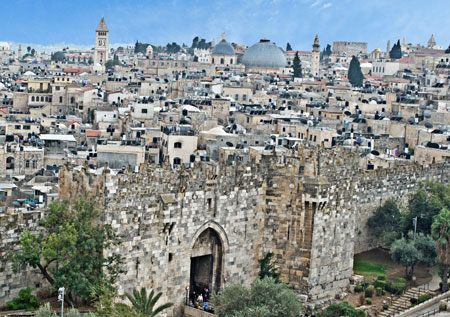Email: right2edu@birzeit.edu | Phone: 0097(0)2-298-2059
Survey on the Impact of the Expansion and Annexation Wall on the Social and Economical Conditions of the Palestinian Households
On the Main Findings of the Survey on the Impact of the Expansion and Annexation Wall on the Social and Economical Conditions of the Palestinian Households in the Localities which the Wall Pass Through (July 2004)
The Expansion and Annexation Wall Impelled 31% of the Population at the Localities Affected By the Wall to Think about Changing Their Place of Residence, and 80.7% of the Households Living West of the Wall Have Been Separated From the Basic Medical Services, and 86.0% of the Confiscated Land Was Used For Agriculture, and the Wall Influenced the Social Relationships for 90.7% of the Households Living West of the Wall.
Palestinian Central Bureau of Statistics “PCBS” conducted a household survey in the Palestinian localities where the Expansion and Annexation wall passes through. The sample size was 3,615 households, while the sample size for completed questionnaires was 2,689 households, of which 293 located west of the Expansion and Annexation wall and 2,396 east of the wall. Data collection took place during July 2004 This survey comes as a part of the surveillance system to monitor the impact of the Israeli measures on the well being of the Palestinian people.
The effect of the Expansion and Annexation Wall and the Security Situation on the education:
The results revealed that 3.4% of the individuals in the localities affected by the wall left their education due to the security situation and the expansion and annexation wall, (5.3% west of the wall and 3.1% east of the wall), while it’s noticed that 26.0% of the individuals in the affected localities left their education due to the bad economic conditions, (31.7% west of the wall and 25.2% east of the wall).
The results show that 81.5% of Palestinian households in the localities affected by the wall that have some members attending higher education used detour roads in order to reach their universities and colleges as a method of adaptation with the difficulties they face, (81.1% west of the wall and 81.6% east of the wall), 81.0% of the households were forced to be absent from university and college due to the closure (77.9% west of the wall and 81.6% east of the wall).
Changing place of residence or thinking of change:
The results revealed that the percentage of the individuals living west of the wall in the north of the West Bank who changed their place of residence was 2.8%, compared with 16.7% at the east side of the wall, while in the middle of the West Bank this percentage was 39.6% for west of the wall and 18.0% for east of the wall, and the same percentage at the south of the West Bank was 15.8% west of the wall and 13.1% east of the wall.
Also the results showed that the percentage of the individuals aged 16 years or more who are thinking to change their place of residence and living to the west of the wall in the north of the West Bank was 2.1%, comparing to 2.2% for who are living to the east side of the wall. While in the middle of the West Bank this percentage was 22.7% for west of the wall, and 4.4% for east of the wall. At the south of the West Bank the percentage of who are thinking to change their place of residence was 2.3% for east of the wall.
Families dissociation from each other and from relatives:
30.6% of Palestinian households or one of their individuals in the localities affected by the expansion and annexation wall have been separated from relatives (45.3% west of the wall and 28.8% east of the wall). The results also revealed that 2.6% of the Palestinian households in the localities affected by the wall have been separated from the father (1.8% west of the wall and 2.7% east of the wall).
Separation from health services and obstacles against movements and transportation:
The survey results indicated that 80.7% of the Palestinian households living west of the wall indicated that separation from the health services (hospitals and medical centers) in the main cities formed an obstacle for them to get the required health services, while this percentage was 48.6% in the east side of the wall. Also the disability of medical staff to reach the localities formed obstacle for 78.0% of the households located west of the wall and 42.3% of the households located east of the wall. The results concerning the obstacles against movement and transportation for individuals/some of the individuals living west of the wall also showed that 90.0% of the Palestinian households reported that the time required for transportation and crossing checkpoints was a main obstacle against movement.
Land confiscation:
The results revealed that the percentage of households whose lands were confiscated totally was 9.1% of the households living west of the wall against 24.9% for east of the wall, while the percentage of the households living west of the wall whose parts of their land were confiscated was 19.9% against 20.3% for east of the wall. It’s noticed that most of the confiscated land in the localities affected by the wall were used for agriculture, and it amounted 86.0%.
Labor market in the localities affected by the wall:
The rate of unemployment in the localities affected by the expansion and annexation wall amounted 30.9%, (25.2% west of the wall and 31.6% east of the wall).
Most of the workers in the localities affected by the wall were paid workers as their percentage were 73.6% for west of the wall, and 62.8% for east of the wall. While it’s noticeable that the percentages of employers and self-employed workers amounted 10.1% and 13.8% respectively in the localities west of the wall. The results also revealed that 13.8% of workers in the localities affected by the wall works in Israel and settlements (24.6 % west of the wall and 12.4% east of the wall).
Humanitarian aid Results show that 13.2% of households or one/some of their individuals in the localities affected by the wall reported that they received humanitarian assistance during June 2004, (7.3% west of the wall and 13.9% east of the wall). While 81.2% of the households reported that they received assistance for only one time (85.4% west of the wall and 80.9% east of the wall).
Concerning the kind of assistance 43.4% of the total assistance were provided in the form of food supplies (42.8% west of the wall and 43.5% east of the wall), and 40.4% were in cash (46.9% west of the wall and 39.9% east of the wall).
However, the frequency of providing the assistance for households, relatives were rated highest rank at 30.0%, followed by Ministry of Social Affairs by 27.7%, then from UNRWA by 11.8%.
Steadfastness strategies:
The results indicated that the households in the Palestinian localities affected by the wall depended on several methods to steadfast during the last six months, as 89.3% of the households in the Palestinian Territory reported that they depend on their monthly income (92.4% west of the wall and 88.1% east of the wall), where as 84.3% of the Palestinian households reduced there monthly expenditure (69.6% west of the wall and 89.6% east of the wall), and 70.9% delayed payment of bills (63.3% west of the wall and 73.6% east of the wall).
Income Sources
Results of the survey indicated that 37.4% of the Palestinian households living west of the wall depended on wages and salaries from Palestinian private sector as a main income source before the construction of the wall, against 38.4% depend on this source after the construction of the wall, also 32.9% of the Palestinian households living west of the wall depended on wages and salaries from the Israeli working sectors before the construction of the wall, against 28.4% depend on the same source after the construction of the wall.
While in the localities located east of the wall 34.4% of the households depended on wages and salaries from the Israeli working sectors before the construction of the wall, against 13.5% depend on this source after the construction of the wall, and 29.8% depended on wages and salaries from Palestinian private sector before the construction of the wall and 35.1% depend on the same source after the construction of the wall.
Priority needs of households
The results reveal that 38.5% of households in the localities affected by the expansion and annexation wall reported the need for work as top priority for their localities (23.5% west of the wall and 40.3% east of the wall), and 25.4% of the households reported the need for improving the infrastructure in their localities as top priority for these localities (43.2% west of the wall and 23.3% east of the wall), while 13.6% of households expressed the need for medical services in their localities (16.0% west of the wall and 13.3% east of the wall), and 11.1% of households in the localities affected by the wall expressed the need for security and stability as a top priority for their localities (9.3% west of the wall and 11.3% east of the wall).
Concerning the needs of the households the results showed that 53.5% of the households in the localities affected by the expansion and annexation wall expressed the need for food as a top priority (52.2% west of the wall and 53.6% east of the wall), and 12.9% of households expressed the need for money (18.5% west of the wall and 12.3% east of the wall), while 9.8% of the households expressed the need for work (6.6% west of the wall and 10.2% east of the wall).
Effects of the wall on the family and social relationships:
The results showed that 90.7% of households living west of the wall had their ability to visit family and relatives been affected by the wall, against 70.6% of the households living east of the wall. The wall also affected the ability of households to visit religious and holy places at 89.5% for west of the wall, against 81.8% for east of the wall.
The survey results indicated that the percentage of households living west of the wall who have obstacles to marry a partner living in the other side of the wall raised from12.6% before the construction of the wall to 64.2% after this construction. It’s noticed that the percentage of households west of the wall that have obstacles to marry a partner living in the other side of the wall raised heavily since the wall construction, as it was 9.1% before this construction and it becomes 57.3% after that.
Availability of holding:
The results showed that 24.9% of the households in the localities affected by the expansion and annexation wall have holdings (14.3% west of the wall and 26.1% east of the wall). Concerning the kind of holdings 74.0% of the households affected by wall said that they have only plant holdings, while 11.8% of the households said that they have only animal holdings
More Articles
Under Israeli blockade of Gaza,...
Israel does not explicitly ban importing books to...



